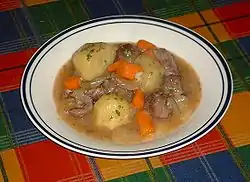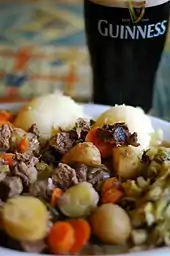Irish stew
Irish stew (Irish: stobhach/Stobhach Gaelach)[1] is a lamb or mutton and root vegetable stew native to Ireland. As in all traditional folk dishes, the exact recipe is not consistent from time to time, or place to place. Basic ingredients include lamb, or mutton (mutton is used as it comes from less tender sheep over a year old, is fattier, and has a stronger flavour, and was generally more common in less-affluent times), as well as potatoes, onions, and parsley.[2] It may sometimes also include carrots. Irish stew is also made with kid goat.
Irish stew is a celebrated Irish dish, yet its composition is a matter of dispute. Purists maintain that the only acceptable and traditional ingredients are neck mutton chops or kid, potatoes, onions, and water. Others would add such items as carrots, turnips and pearl barley; but the purists maintain that they spoil the true flavour of the dish. The ingredients are boiled and simmered slowly for up to two hours. Mutton was the dominant ingredient because the economic importance of sheep lay in their wool and milk produce and this ensured that only old or economically non-viable animals ended up in the cooking pot, where they needed hours of slow cooking. Irish stew is the product of a culinary tradition that relied almost exclusively on cooking over an open fire. It seems that Irish stew was recognised as early as about 1800.[3]
 A plate of Irish stew | |
| Type | Stew |
|---|---|
| Course | Main course |
| Place of origin | Ireland |
| Serving temperature | Hot |
| Main ingredients | Lamb, potatoes, carrots, onions, parsley |
Irish stew is considered a national dish of Ireland.[4]
History

Stewing is an ancient method of cooking meats that is common throughout the world. After the idea of the cauldron was imported from continental Europe and/or Britain, the cauldron (along with the already established spit) became the dominant cooking tool in ancient Ireland, ovens being practically unknown to the ancient Gaels.[5] The cauldron, along with flesh-hooks for suspending the meat, eventually became preferred over the spit for feasting purposes, as evidenced by archaeological findings that indicate a predominance of flesh hooks over roasting spits in Ireland and Britain.[6] Many food historians believe that goat was originally the meat of choice, eventually being supplanted by beef and mutton.[7]
The root vegetables and meat (originally goat) for the stew were then all in place, save for the potato. The introduction of the potato, originally a South American crop, did not occur until after the 16th century.
A 19th-century American recipe was recorded by Helen Stuart Campbell, a professor of domestic science at Kansas State Agricultural Culture. According to Campbell the stew was made with boneless beef or mutton, trimmed of fat and cut into small cubes, less than one inch square. To its broth were added onions and potatoes, and carrots (if beef was used), with a simple seasoning of salt and pepper. This stew was gently simmered for several hours and thickened with flour before serving.[8]
Laws and regulations
Canada
According to Canadian regulations, commercially produced Irish stew must contain at least 20% mutton, lamb, and 30% vegetables. It may also include gravy, salt, seasoning, and spices.[9]
See also
References
- "Irish stew". téarma.ie – Dictionary of Irish Terms. Foras na Gaeilge and Dublin City University. Retrieved 18 Nov 2016.
- "Home Cooking: Traditional Irish Stew". Homecooking.about.com. 2012-04-10. Retrieved 2012-04-27.
- Davidson, Alan. (2006). Oxford Companion to Food. Oxford: Oxford University Press. (p. 409).
- "Top 10 National Dishes -- National Geographic". Travel. 2011-09-13. Retrieved 2020-08-08.
- "A History of Irish Cuisine". Ravensgard.org. Retrieved 2012-04-27.
- Cunliffe, Barry (2013). Britain Begins. Oxford: Oxford University Press. pp. 273–276. ISBN 9780199679454. OCLC 802685975.
- "How to cook an Irish stew". tribunedigital-chicagotribune. Retrieved 3 July 2015.
- Scharnhorst, Gary. Literary Eats. McFarland. p. 30.
- "Archived copy". Archived from the original on 2017-07-12. Retrieved 2017-07-14.CS1 maint: archived copy as title (link)
Bibliography
- Davidson, Alan (2006). "Irish stew". In Jaine, Tom (ed.). Oxford Companion to Food (2nd ed.). Oxford: Oxford University Press. ISBN 9780192806819. OCLC 803887690.
